Impacts of Monitored Physical Exercises on Type 2 Diabetic Patients Aged between 50 to 69 Years
VerifiedAdded on 2023/03/31
|7
|1449
|55
AI Summary
This study examines the impacts of monitored physical exercises on type 2 diabetic patients aged between 50 to 69 years. It aims to determine whether daily jogging, walking, or running accompanied by a physical therapist have beneficial effects compared to an unmonitored group.
Contribute Materials
Your contribution can guide someone’s learning journey. Share your
documents today.
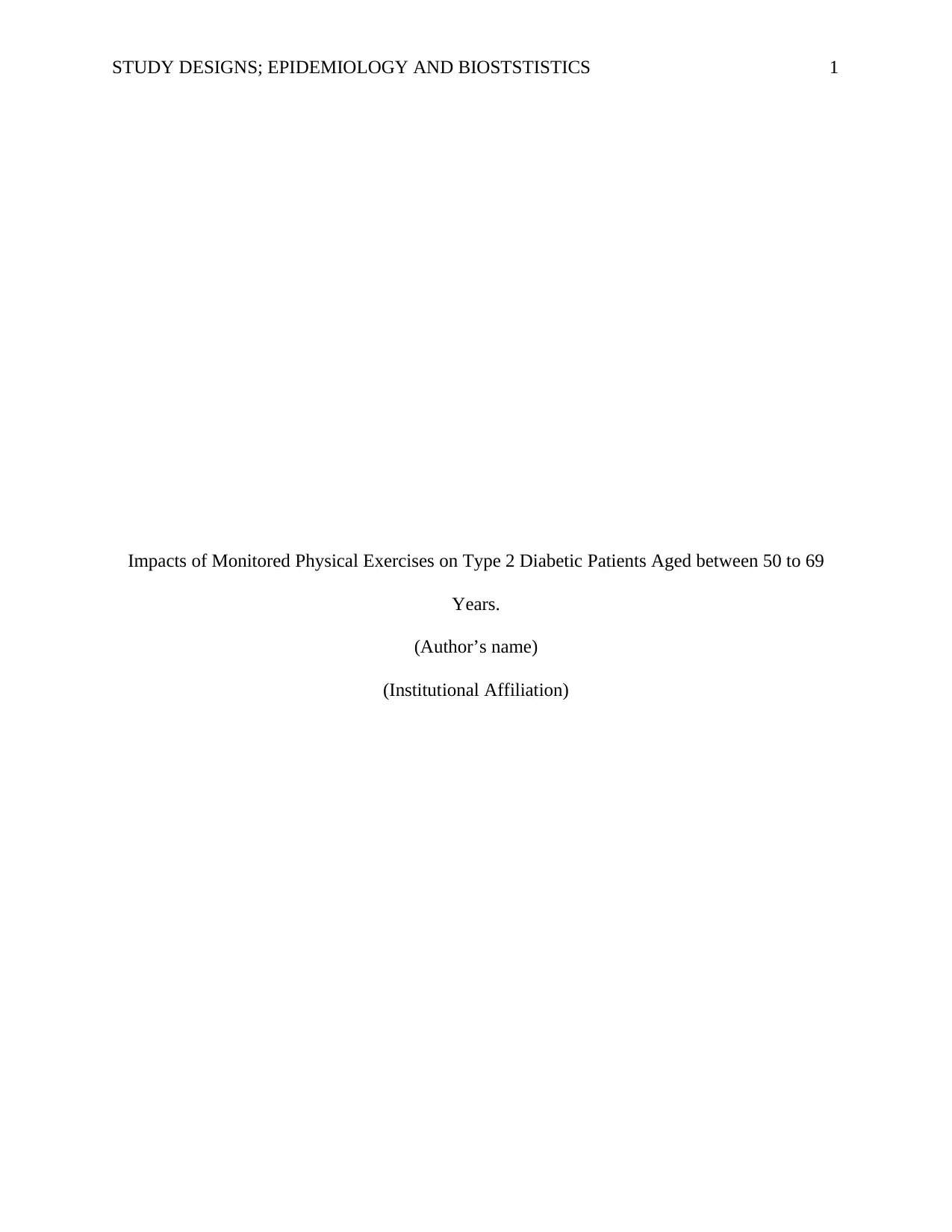
STUDY DESIGNS; EPIDEMIOLOGY AND BIOSTSTISTICS 1
Impacts of Monitored Physical Exercises on Type 2 Diabetic Patients Aged between 50 to 69
Years.
(Author’s name)
(Institutional Affiliation)
Impacts of Monitored Physical Exercises on Type 2 Diabetic Patients Aged between 50 to 69
Years.
(Author’s name)
(Institutional Affiliation)
Secure Best Marks with AI Grader
Need help grading? Try our AI Grader for instant feedback on your assignments.

STUDY DESIGNS; EPIDEMIOLOGY AND BIOSTSTISTICS 2
Research Question
What are the impacts of monitored physical exercises on type 2 diabetic patients aged between
50 to 69 years?
Problem Identification
According to the Australian Institute of Health and Welfare (AIWH) 2018, there were
about 700,000 people in Australia diagnosed with diabetes between 2004 and 2005(1). The
number has been increasing from year to year with a corresponding increase in diabetes
cardiovascular associated diseases(1). Daily physical exercises improve glycemic metabolism
and control, and also reduce risks for cardiovascular diseases(2). However, the extent and
adherence of patients’ physical exercises are not well known. Despite patient education and
follow up, many patients will assume a certain amount of physical activity in a given duration of
time is enough(3). This study intends to check whether monitored physical activities specifically
daily jogging, walking or running accompanied by a physical therapist will have beneficial
effects as compared to the unmonitored group using experimental epidemiological design for six
months. Experimental epidemiological study design intends to check whether certain
interventions are suitable in controlling or preventing disease comparing with others(4).
Specifically, this study will be employed a randomized control trials design(2). In this case, a
group of patients will be receiving monitored daily physical activities including running, jogging
or walking for four kilometers daily. The control group will receive similar patient education on
physical exercises but will not be monitored.
Study Participants
The study participants in this research will include all patients who have been diagnosed
with type two diabetes and are currently on treatment. All participants must be between 50 to 69
Research Question
What are the impacts of monitored physical exercises on type 2 diabetic patients aged between
50 to 69 years?
Problem Identification
According to the Australian Institute of Health and Welfare (AIWH) 2018, there were
about 700,000 people in Australia diagnosed with diabetes between 2004 and 2005(1). The
number has been increasing from year to year with a corresponding increase in diabetes
cardiovascular associated diseases(1). Daily physical exercises improve glycemic metabolism
and control, and also reduce risks for cardiovascular diseases(2). However, the extent and
adherence of patients’ physical exercises are not well known. Despite patient education and
follow up, many patients will assume a certain amount of physical activity in a given duration of
time is enough(3). This study intends to check whether monitored physical activities specifically
daily jogging, walking or running accompanied by a physical therapist will have beneficial
effects as compared to the unmonitored group using experimental epidemiological design for six
months. Experimental epidemiological study design intends to check whether certain
interventions are suitable in controlling or preventing disease comparing with others(4).
Specifically, this study will be employed a randomized control trials design(2). In this case, a
group of patients will be receiving monitored daily physical activities including running, jogging
or walking for four kilometers daily. The control group will receive similar patient education on
physical exercises but will not be monitored.
Study Participants
The study participants in this research will include all patients who have been diagnosed
with type two diabetes and are currently on treatment. All participants must be between 50 to 69

STUDY DESIGNS; EPIDEMIOLOGY AND BIOSTSTISTICS 3
years, including both males and females with the informed education of the benefits of physical
exercises. The study sample population will include a hundred participants of which 50
individuals will receive a monitoring program and 50 persons will not. Both categories will
receive patient education on the benefits of physical exercises. The study will exclude all other
individuals who are not diabetic, receiving treatment in a recognized public hospital, have no
prior knowledge on benefits of physical exercises and are not within the age bracket.
Case group
The case group will include 50 individuals who are type 2 diabetic aged between 50 and
69 years. All the members in the case group will include 25 women and 25 men who are
currently under treatment and are aware of the benefits of physical activities.
Controlled group
The controlled group will consist of 50 people with type 2 diabetic and also within the
same age bracket. All individuals in a controlled group will receive patient education on physical
exercises and their benefits but will not be monitored within the study period.
Patient outcomes
There are four major criteria that will be used to measure patients’ outcomes in both case
and control groups. These include the percentage of glycated hemoglobin, fasting plasma
glucose, oral tolerance test, and the classic symptoms test including weight and polyuria(3). All
final tests will be compared with the tests at the beginning of the study. Monitored daily physical
exercises are expected to have more positive outcomes(3).
Covariates to be collected with rationale
All physical activities in the case group will be collected and recorded. This includes the
distance and type of physical activity done such as running, jogging and walking as they may
years, including both males and females with the informed education of the benefits of physical
exercises. The study sample population will include a hundred participants of which 50
individuals will receive a monitoring program and 50 persons will not. Both categories will
receive patient education on the benefits of physical exercises. The study will exclude all other
individuals who are not diabetic, receiving treatment in a recognized public hospital, have no
prior knowledge on benefits of physical exercises and are not within the age bracket.
Case group
The case group will include 50 individuals who are type 2 diabetic aged between 50 and
69 years. All the members in the case group will include 25 women and 25 men who are
currently under treatment and are aware of the benefits of physical activities.
Controlled group
The controlled group will consist of 50 people with type 2 diabetic and also within the
same age bracket. All individuals in a controlled group will receive patient education on physical
exercises and their benefits but will not be monitored within the study period.
Patient outcomes
There are four major criteria that will be used to measure patients’ outcomes in both case
and control groups. These include the percentage of glycated hemoglobin, fasting plasma
glucose, oral tolerance test, and the classic symptoms test including weight and polyuria(3). All
final tests will be compared with the tests at the beginning of the study. Monitored daily physical
exercises are expected to have more positive outcomes(3).
Covariates to be collected with rationale
All physical activities in the case group will be collected and recorded. This includes the
distance and type of physical activity done such as running, jogging and walking as they may
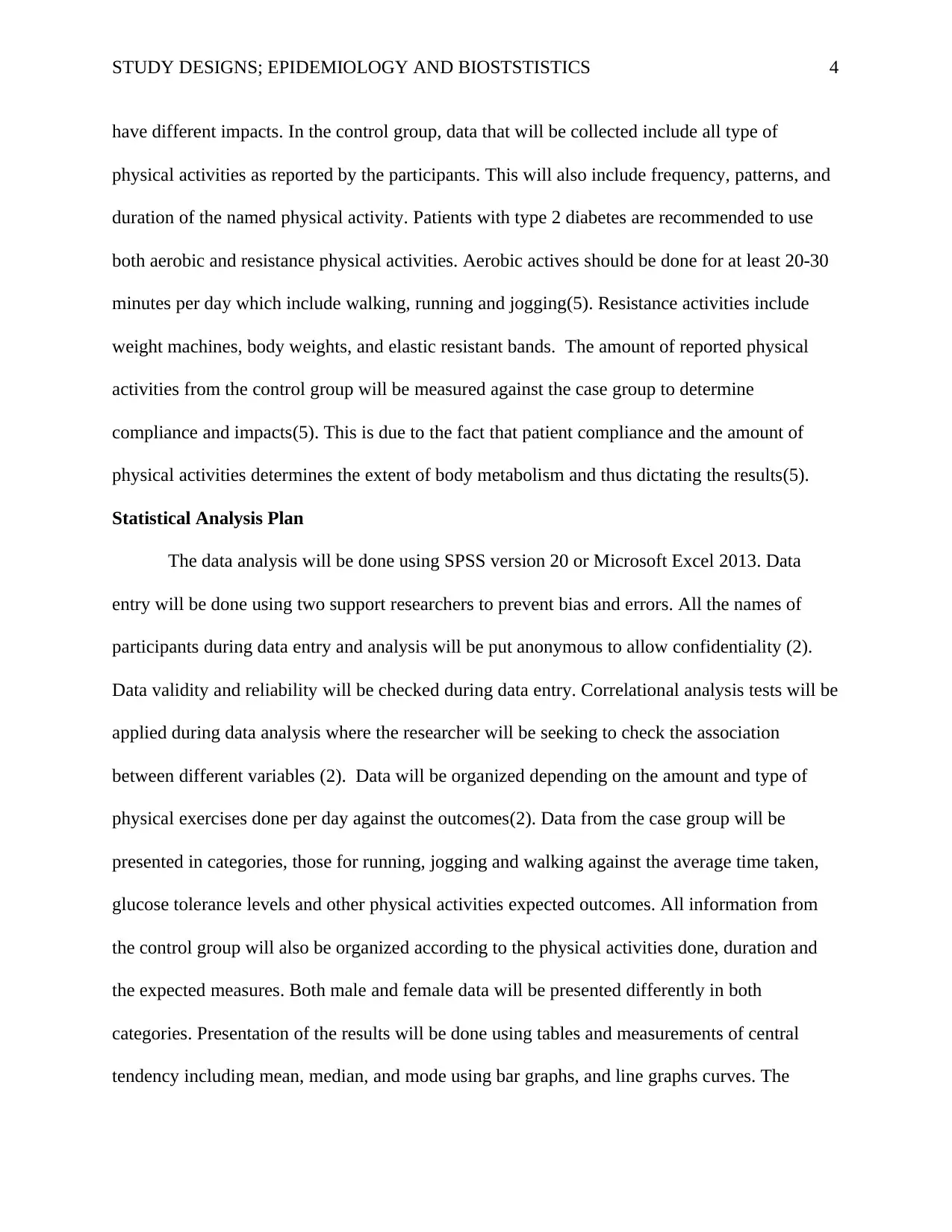
STUDY DESIGNS; EPIDEMIOLOGY AND BIOSTSTISTICS 4
have different impacts. In the control group, data that will be collected include all type of
physical activities as reported by the participants. This will also include frequency, patterns, and
duration of the named physical activity. Patients with type 2 diabetes are recommended to use
both aerobic and resistance physical activities. Aerobic actives should be done for at least 20-30
minutes per day which include walking, running and jogging(5). Resistance activities include
weight machines, body weights, and elastic resistant bands. The amount of reported physical
activities from the control group will be measured against the case group to determine
compliance and impacts(5). This is due to the fact that patient compliance and the amount of
physical activities determines the extent of body metabolism and thus dictating the results(5).
Statistical Analysis Plan
The data analysis will be done using SPSS version 20 or Microsoft Excel 2013. Data
entry will be done using two support researchers to prevent bias and errors. All the names of
participants during data entry and analysis will be put anonymous to allow confidentiality (2).
Data validity and reliability will be checked during data entry. Correlational analysis tests will be
applied during data analysis where the researcher will be seeking to check the association
between different variables (2). Data will be organized depending on the amount and type of
physical exercises done per day against the outcomes(2). Data from the case group will be
presented in categories, those for running, jogging and walking against the average time taken,
glucose tolerance levels and other physical activities expected outcomes. All information from
the control group will also be organized according to the physical activities done, duration and
the expected measures. Both male and female data will be presented differently in both
categories. Presentation of the results will be done using tables and measurements of central
tendency including mean, median, and mode using bar graphs, and line graphs curves. The
have different impacts. In the control group, data that will be collected include all type of
physical activities as reported by the participants. This will also include frequency, patterns, and
duration of the named physical activity. Patients with type 2 diabetes are recommended to use
both aerobic and resistance physical activities. Aerobic actives should be done for at least 20-30
minutes per day which include walking, running and jogging(5). Resistance activities include
weight machines, body weights, and elastic resistant bands. The amount of reported physical
activities from the control group will be measured against the case group to determine
compliance and impacts(5). This is due to the fact that patient compliance and the amount of
physical activities determines the extent of body metabolism and thus dictating the results(5).
Statistical Analysis Plan
The data analysis will be done using SPSS version 20 or Microsoft Excel 2013. Data
entry will be done using two support researchers to prevent bias and errors. All the names of
participants during data entry and analysis will be put anonymous to allow confidentiality (2).
Data validity and reliability will be checked during data entry. Correlational analysis tests will be
applied during data analysis where the researcher will be seeking to check the association
between different variables (2). Data will be organized depending on the amount and type of
physical exercises done per day against the outcomes(2). Data from the case group will be
presented in categories, those for running, jogging and walking against the average time taken,
glucose tolerance levels and other physical activities expected outcomes. All information from
the control group will also be organized according to the physical activities done, duration and
the expected measures. Both male and female data will be presented differently in both
categories. Presentation of the results will be done using tables and measurements of central
tendency including mean, median, and mode using bar graphs, and line graphs curves. The
Paraphrase This Document
Need a fresh take? Get an instant paraphrase of this document with our AI Paraphraser
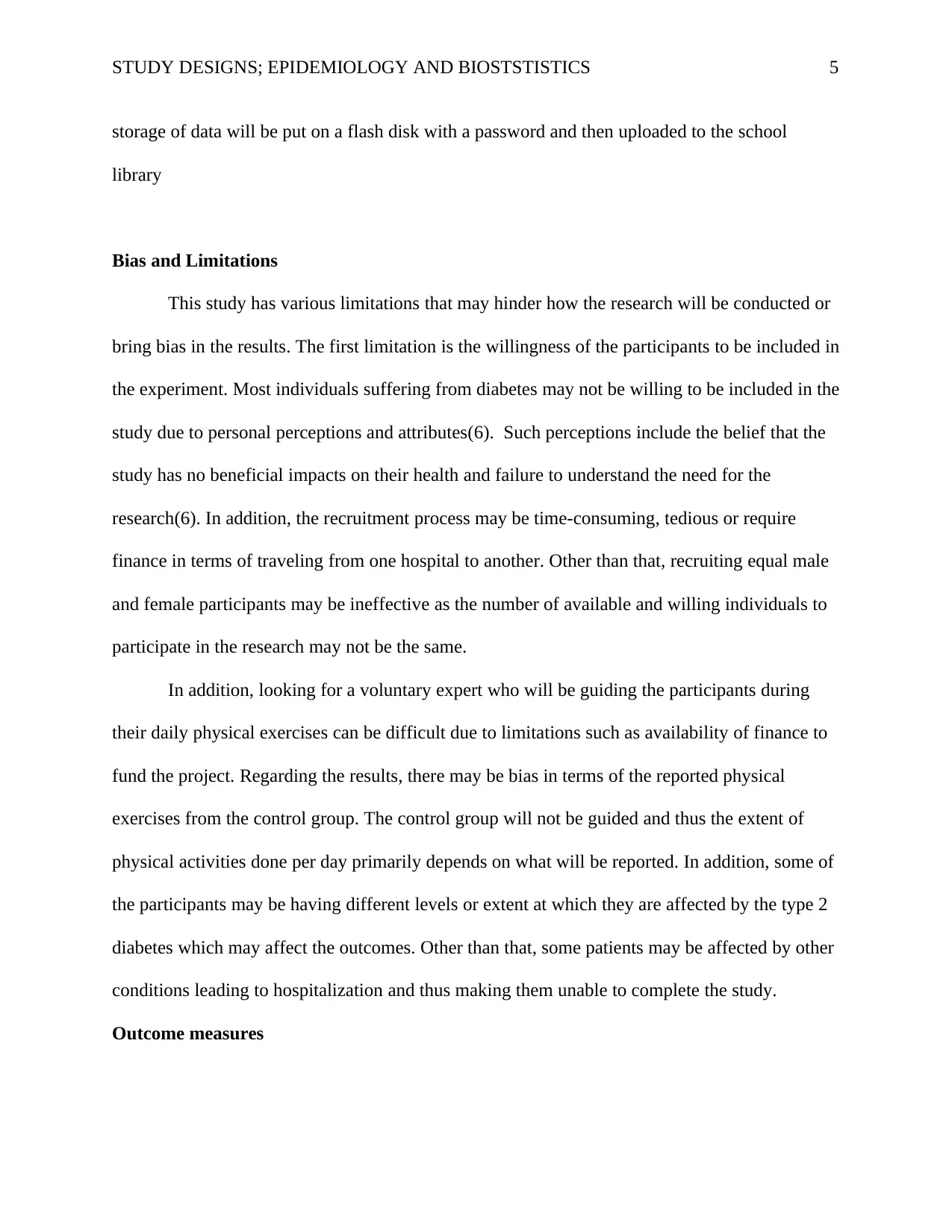
STUDY DESIGNS; EPIDEMIOLOGY AND BIOSTSTISTICS 5
storage of data will be put on a flash disk with a password and then uploaded to the school
library
Bias and Limitations
This study has various limitations that may hinder how the research will be conducted or
bring bias in the results. The first limitation is the willingness of the participants to be included in
the experiment. Most individuals suffering from diabetes may not be willing to be included in the
study due to personal perceptions and attributes(6). Such perceptions include the belief that the
study has no beneficial impacts on their health and failure to understand the need for the
research(6). In addition, the recruitment process may be time-consuming, tedious or require
finance in terms of traveling from one hospital to another. Other than that, recruiting equal male
and female participants may be ineffective as the number of available and willing individuals to
participate in the research may not be the same.
In addition, looking for a voluntary expert who will be guiding the participants during
their daily physical exercises can be difficult due to limitations such as availability of finance to
fund the project. Regarding the results, there may be bias in terms of the reported physical
exercises from the control group. The control group will not be guided and thus the extent of
physical activities done per day primarily depends on what will be reported. In addition, some of
the participants may be having different levels or extent at which they are affected by the type 2
diabetes which may affect the outcomes. Other than that, some patients may be affected by other
conditions leading to hospitalization and thus making them unable to complete the study.
Outcome measures
storage of data will be put on a flash disk with a password and then uploaded to the school
library
Bias and Limitations
This study has various limitations that may hinder how the research will be conducted or
bring bias in the results. The first limitation is the willingness of the participants to be included in
the experiment. Most individuals suffering from diabetes may not be willing to be included in the
study due to personal perceptions and attributes(6). Such perceptions include the belief that the
study has no beneficial impacts on their health and failure to understand the need for the
research(6). In addition, the recruitment process may be time-consuming, tedious or require
finance in terms of traveling from one hospital to another. Other than that, recruiting equal male
and female participants may be ineffective as the number of available and willing individuals to
participate in the research may not be the same.
In addition, looking for a voluntary expert who will be guiding the participants during
their daily physical exercises can be difficult due to limitations such as availability of finance to
fund the project. Regarding the results, there may be bias in terms of the reported physical
exercises from the control group. The control group will not be guided and thus the extent of
physical activities done per day primarily depends on what will be reported. In addition, some of
the participants may be having different levels or extent at which they are affected by the type 2
diabetes which may affect the outcomes. Other than that, some patients may be affected by other
conditions leading to hospitalization and thus making them unable to complete the study.
Outcome measures
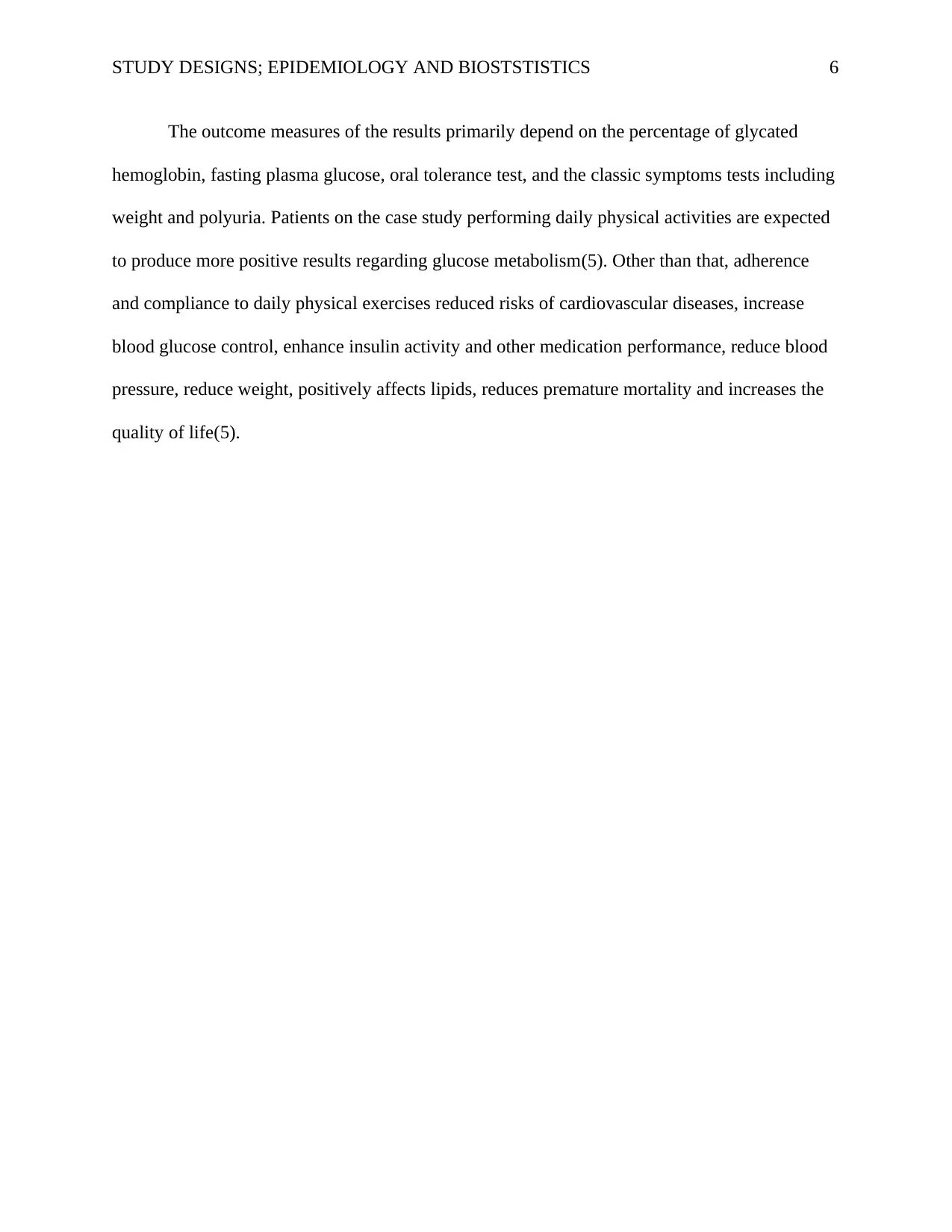
STUDY DESIGNS; EPIDEMIOLOGY AND BIOSTSTISTICS 6
The outcome measures of the results primarily depend on the percentage of glycated
hemoglobin, fasting plasma glucose, oral tolerance test, and the classic symptoms tests including
weight and polyuria. Patients on the case study performing daily physical activities are expected
to produce more positive results regarding glucose metabolism(5). Other than that, adherence
and compliance to daily physical exercises reduced risks of cardiovascular diseases, increase
blood glucose control, enhance insulin activity and other medication performance, reduce blood
pressure, reduce weight, positively affects lipids, reduces premature mortality and increases the
quality of life(5).
The outcome measures of the results primarily depend on the percentage of glycated
hemoglobin, fasting plasma glucose, oral tolerance test, and the classic symptoms tests including
weight and polyuria. Patients on the case study performing daily physical activities are expected
to produce more positive results regarding glucose metabolism(5). Other than that, adherence
and compliance to daily physical exercises reduced risks of cardiovascular diseases, increase
blood glucose control, enhance insulin activity and other medication performance, reduce blood
pressure, reduce weight, positively affects lipids, reduces premature mortality and increases the
quality of life(5).
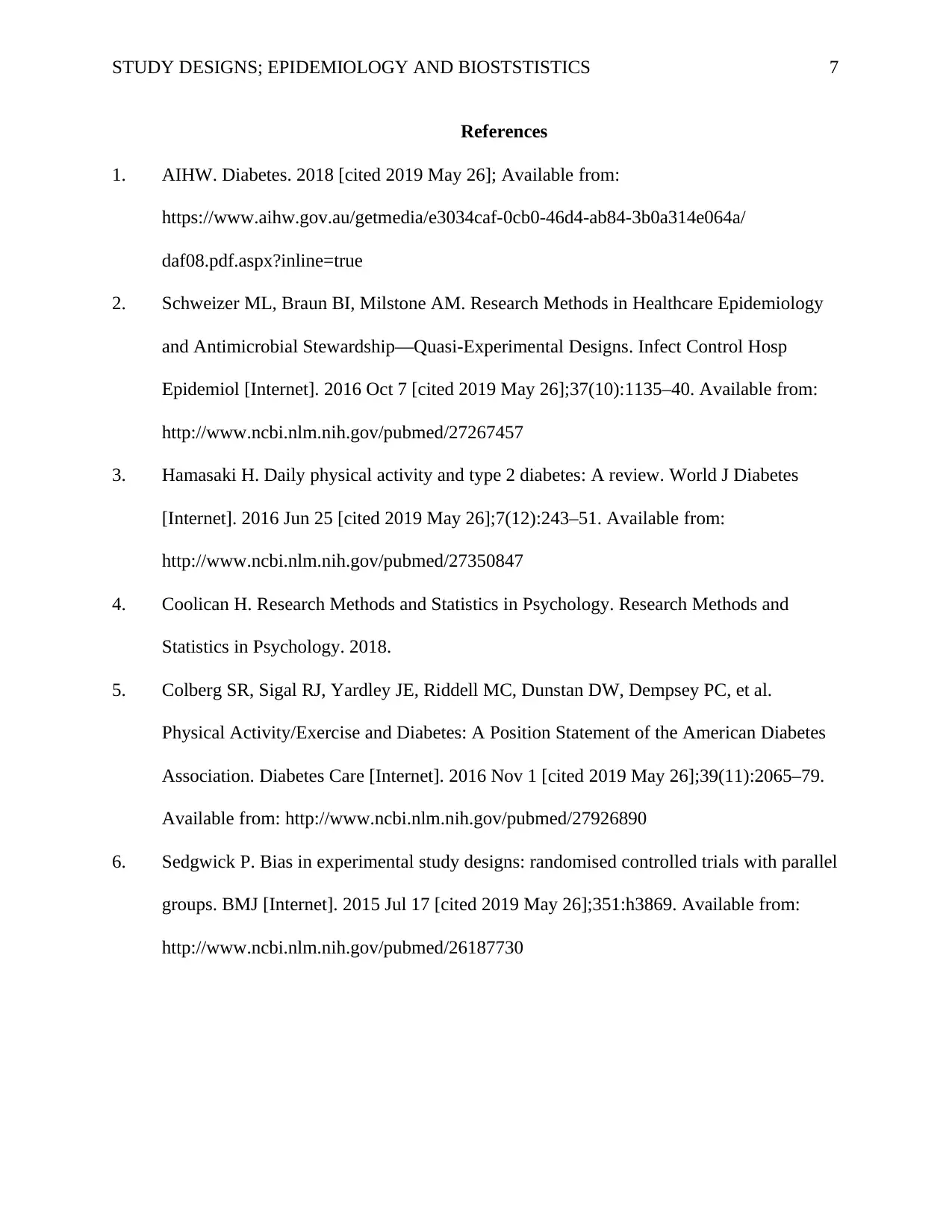
STUDY DESIGNS; EPIDEMIOLOGY AND BIOSTSTISTICS 7
References
1. AIHW. Diabetes. 2018 [cited 2019 May 26]; Available from:
https://www.aihw.gov.au/getmedia/e3034caf-0cb0-46d4-ab84-3b0a314e064a/
daf08.pdf.aspx?inline=true
2. Schweizer ML, Braun BI, Milstone AM. Research Methods in Healthcare Epidemiology
and Antimicrobial Stewardship—Quasi-Experimental Designs. Infect Control Hosp
Epidemiol [Internet]. 2016 Oct 7 [cited 2019 May 26];37(10):1135–40. Available from:
http://www.ncbi.nlm.nih.gov/pubmed/27267457
3. Hamasaki H. Daily physical activity and type 2 diabetes: A review. World J Diabetes
[Internet]. 2016 Jun 25 [cited 2019 May 26];7(12):243–51. Available from:
http://www.ncbi.nlm.nih.gov/pubmed/27350847
4. Coolican H. Research Methods and Statistics in Psychology. Research Methods and
Statistics in Psychology. 2018.
5. Colberg SR, Sigal RJ, Yardley JE, Riddell MC, Dunstan DW, Dempsey PC, et al.
Physical Activity/Exercise and Diabetes: A Position Statement of the American Diabetes
Association. Diabetes Care [Internet]. 2016 Nov 1 [cited 2019 May 26];39(11):2065–79.
Available from: http://www.ncbi.nlm.nih.gov/pubmed/27926890
6. Sedgwick P. Bias in experimental study designs: randomised controlled trials with parallel
groups. BMJ [Internet]. 2015 Jul 17 [cited 2019 May 26];351:h3869. Available from:
http://www.ncbi.nlm.nih.gov/pubmed/26187730
References
1. AIHW. Diabetes. 2018 [cited 2019 May 26]; Available from:
https://www.aihw.gov.au/getmedia/e3034caf-0cb0-46d4-ab84-3b0a314e064a/
daf08.pdf.aspx?inline=true
2. Schweizer ML, Braun BI, Milstone AM. Research Methods in Healthcare Epidemiology
and Antimicrobial Stewardship—Quasi-Experimental Designs. Infect Control Hosp
Epidemiol [Internet]. 2016 Oct 7 [cited 2019 May 26];37(10):1135–40. Available from:
http://www.ncbi.nlm.nih.gov/pubmed/27267457
3. Hamasaki H. Daily physical activity and type 2 diabetes: A review. World J Diabetes
[Internet]. 2016 Jun 25 [cited 2019 May 26];7(12):243–51. Available from:
http://www.ncbi.nlm.nih.gov/pubmed/27350847
4. Coolican H. Research Methods and Statistics in Psychology. Research Methods and
Statistics in Psychology. 2018.
5. Colberg SR, Sigal RJ, Yardley JE, Riddell MC, Dunstan DW, Dempsey PC, et al.
Physical Activity/Exercise and Diabetes: A Position Statement of the American Diabetes
Association. Diabetes Care [Internet]. 2016 Nov 1 [cited 2019 May 26];39(11):2065–79.
Available from: http://www.ncbi.nlm.nih.gov/pubmed/27926890
6. Sedgwick P. Bias in experimental study designs: randomised controlled trials with parallel
groups. BMJ [Internet]. 2015 Jul 17 [cited 2019 May 26];351:h3869. Available from:
http://www.ncbi.nlm.nih.gov/pubmed/26187730
1 out of 7
![[object Object]](/_next/static/media/star-bottom.7253800d.svg)





